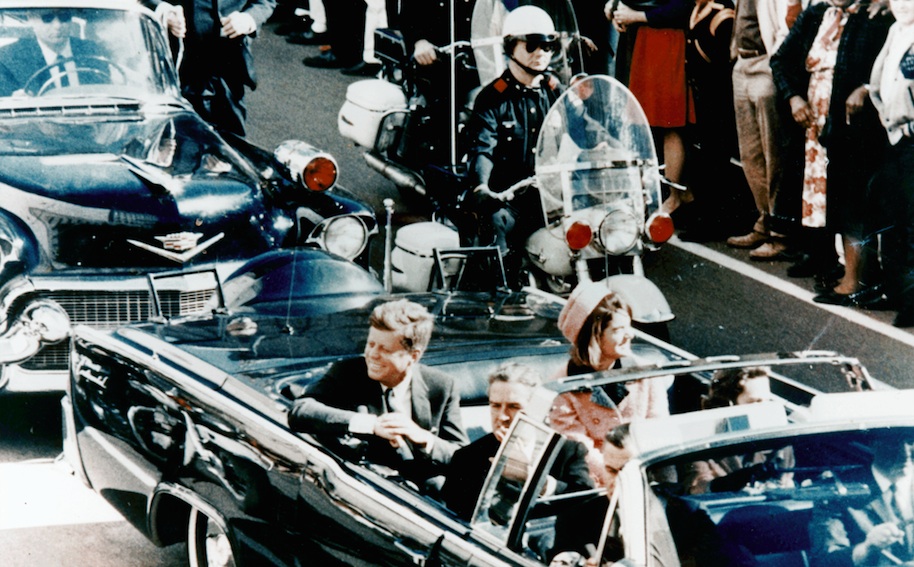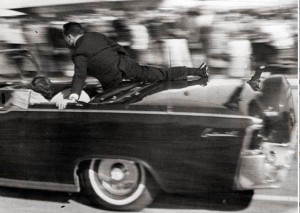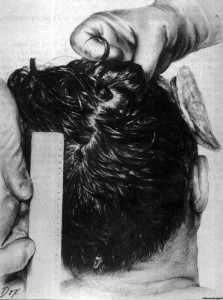
By Patrick Rahill
Ancestral warning for surviving Dallas got lost in translation
President John F Kennedy could not have worn a helmet in Dallas fifty years ago. It was never proposed and would have been deemed inappropriate and even bizarre in the context of a Presidential motorcade. Let us suppose he could have worn a hat that had protective armor – it would have appeared unusual, but not a crass violation of cultural norms. Lee Harvey Oswald would have encountered an obstacle in accomplishing his objective of killing the President of the United States. He could very well have surmounted that obstacle to strike, and even fatally so the President, but it would have been more difficult to do that by a direct shot to the back of the President’s head.
We often hear of hindsight providing 20/20 vision. If agents had ridden on the rear bumper or high – rise buildings including the School Book Depository building had been secure. In the case of the President, however, his very name provided FORESIGHT. His name stated he should be wary of and prepared for a blow to the head; that he should wear protective headgear.
It seems an incredible coincidence as we reflect on this tragedy that the family name of the President – Kennedy – carried for 1000 years a literal instruction to do what would be deemed culturally bizarre – if he had worn a helmet, and socially awkward – if he had worn a hat with protective armor on Friday November 22nd 1963, but which possibly might have saved his life. In the distant past tragic events bred an adaptation which entered the nominal gene of this historic family and insisted on precautions to enhance the family’s chance of survival and dominance.
The name Kennedy in Gaelic is rendered O’Cinneide and it means helmeted head. It is the possessive case for a composite word – Ceann meaning head and eide meaning armor {National Library of Ireland -Rev Patrick Woulfe, Irish Names and Surnames, 1923}. Its first use is recorded as being applied to the family soon after the reign of Brian Boru, the last effective High King of Ireland and its last great leader for a thousand years. Brian Boru was John Kennedy’s illustrious ancestor and John Kennedy was Brian Boru’s illustrious descendent. It is very possible Brian Boru’s family survivors acted on the necessity to improve their chances of survival in combat with the Norsemen. One improvement was an emphasis on effective headgear in order to reduce the disparity with the Norsemen who wore mail from head to hip.
The Kennedy crest perhaps is a manifestation of this preoccupation: three helmets topped by a short sword. The name contains a hereditary instruction emphasizing risk management and safety measures to prevent or minimize head injury. If President Kennedy had been shot through the heart, he would most assuredly have died, but there would be no contradiction between the name and the event. The death of President John F Kennedy which was attained without even rudimentary head protection transgressed the very name Kennedy and contradicted the hereditary wisdom enshrined in the name since the time of his heroic forefather, Brian Boru, who had defeated the Norsemen and died doing so at the Battle of Clontarf, Good Friday April 24, 1014.
On Good Friday April 24,1014 John Kennedy’s ancestor, Brian Boru, High King Of Ireland, was an old man who due to his age – he was at least seventy – did not fight in the battle. Tradition has it Brian was praying for victory in his tent attended merely by his servant. The soldiers assigned to guard the King left to follow the escaping Norsemen as the battle began to turn in Ireland’s favor. When Brodir, the Norse King of the Isle of Man, fleeing the battle with his men happened upon the lightly defended King’s tent, he slew the King and hurried to his ship shouting – “let man call out to man that Brodir felled Brian.” Shortly thereafter, Brian’s soldiers returned to find the undefended King dead. Ireland prevailed but the King and his sons and grandsons including a fifteen year old, were lost in the battle.
From Good Friday 1014 sometime in the late afternoon on the seashore at Clontarf as the Norsemen fled from the battlefield to 12.30pm Nov 22, 1963 after the Dealey Plaza underpass in Dallas and 949 years on, an even greater chieftain in the bloodline was meagerly protected and mortally wounded as a consequence. In almost the final third of the 20th century, it would have been deemed foolish and culturally profane for President Kennedy to abide the direction enshrined in a name created a thousand years before out of harsh events and hard won experience. Nevertheless, a deficit of protection allowed a grave and history bending consequence on November 22nd 1963.

Commentators since have referred to the challenge presented by multi story buildings along the route (in Tampa five days prior on Nov 18 there was an armed police officer on each floor of every building over two stories along the President’s route); and also, to the reluctance of the President and his political advisors to allow the FBI and other agencies charged with the protection of the President to implement stringent security measures if they interfered with meeting, greeting and being clearly seen by the public. He was in Dallas that day to mend fences and increase his political capital in the huge and influential State of Texas as he faced into the 1964 Presidential Campaign. Agents keeping too close a proximity to the President would block the public’s view and also give the impression that the President feared for his safety. Indeed, it had been the practice with all Presidents Truman, Eisenhower and Kennedy to ride in motorcades. It is incredible to note that presidential motorcades underwent little or no modification after President Kennedy’s assassination. They still continued unabated. Presidents Lyndon Johnson and Richard Nixon in the feverish late 60’s and early 70’s rode in numerous motorcades through crowded city streets.
President Kennedy was shot through the neck and throat first and raised his hand there in response. There were no agents standing on the rear bumper to push him down and he stayed erect and his head took the next shot – the fatal shot – five seconds later. It has been pointed out that his back brace and back ailment prevented the President from taking avoidant action. If the President had thrown himself onto the First Lady’s lap instead of responding with querulous surprise at the wound to his throat, he would likely have survived.
His ancient forefathers prepared him by giving him a name with a warning, but he was not prepared for danger and those charged with his protection were not afforded the full opportunity to enforce their expertise. This does not imply treachery or carelessness. Like his great ancestor some forty- five generations before, the contingencies of the campaign and the struggle for victory, required risks are taken, a full commitment made. This allowed space for the anti – hero to take the stage and inflict the lethal stroke.
The laissez faire of politicking and the doctrine of accessibility to the public in an open society controlled the staging of his passage through Dallas and facilitated the meeting with his malevolent and fatal biographer, Lee Harvey Oswald, who without putting pen to paper as he waited in the School Book Depository, penned with his right forefinger in a mere six seconds of authorship an epic and horrendous tragedy.

John Kennedy is sometimes compared to Abraham Lincoln, the Great Emancipator who also died at the hand of an assassin. On June 11, 1963, John Kennedy in his Civil Rights Announcement called on the nation to make America “a land of the free” for all citizens. President Lyndon Johnson, the architect and driving force behind civil rights legislation passed by Congress on July 2, 1964 and Martin Luther King, the Civil Rights Movement’s great founder and leader heralded JFK as a major inspiration in this great change in America. They both invoked John Kennedy’s spirit and abbreviated life and Presidency in their advocacy of civil rights to the Nation.
In the land of his ancestors,President John Fitzgerald Kennedy remains a beloved figure. He even ranks ahead of Patrick Pearse, de Valera and Parnell in the Irish pantheon. He is often thought of for the similarity to Michael Collins, the brave, daring and charismatic leader Ireland had for such a short time who was cut down by an assassin at age 31 on a mission to mend fences with former comrades in his native Cork and bring Ireland’s Civil War to a close. He survived the War with Britain and a price on his head, but he did not survive a visit to his own neighborhood. For both these men such great promise and potential was forecast and foreshadowed, yet sadly their presence was brief and ended so soon and in tragedy.
Because Dallas abbreviated John Kennedy’s life and presidency there is a need to extrapolate the rest of his stifled and stillborn potential. A part of him is missing; and so perhaps, it is grief that moves us to gaze with longing at him on the milk carton as it were. We wonder at what might have been, and how he might have fared managing America’s two greatest problems of that era: Civil Rights and Vietnam. The fact is we can never know if he would have been as successful as LBJ with getting civil rights legislation enacted; nor can we know if he would have avoided the quagmire of Vietnam. We do know that in October 1962 he saved our world from nuclear war and its attendant horrors: the incineration of part of it and the contamination of all of it. America, the whole world owes him an enormous debt of gratitude. That act alone is a powerful legacy. Our world had the good fortune that he and Khruschev were rational opponents who dialed back a fomenting confrontation that was in grave danger of going awry.
John Fitzgerald Kennedy was president for a thousand days. The 22nd in 2013 was on a Friday as it was in 1963. For those who were old enough to remember that day, the first few minutes the news was received is retained in the memory with high fidelity. We have by now exceeded John Kennedy’s age. In John Kennedy’s faith he was familiar with Nov 2nd and indeed all of November as a time to remember and pray for deceased family members and friends. Another Veterans Day has passed with its remembrances. He was a veteran who experienced the extremity of war in the South Pacific; his life almost ended there. As President in October 1962, he must have felt a spasm of fear that the unthinkable had already reached a point of possibility, and that as he deliberated with his staff around the table, the most fearful motion ever might soon be seeking a quorum. His fear would have been for more than his own personal end it would have been for a world calamity he failed to prevent.
The advancement in media technology makes the Zapruder film of his violent death show with horrible clarity the manner of his passing. We pray for him and feel for him again with sorrow and pity whatever our various persuasions. He retains a spacious presence in our memories still all these fifty years later. We are unable and unwilling to forget him.
Patrick Rahill is a catholic priest and psychotherapist living in Florida. He was a nineteen-year-old seminarian in Dublin, Ireland when the news broke on the evening of Friday Nov. 22, 1963.




